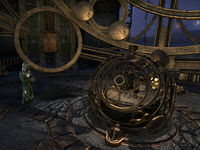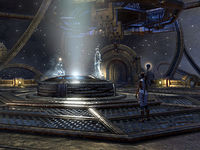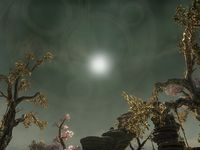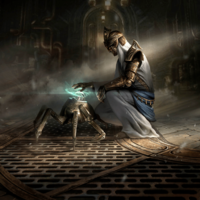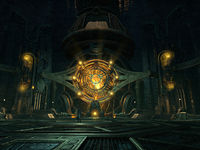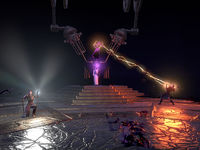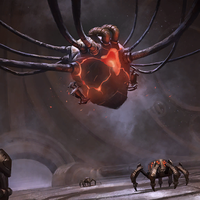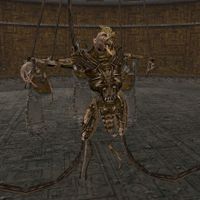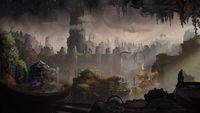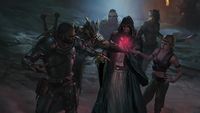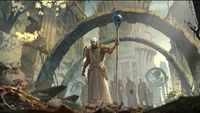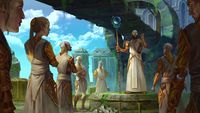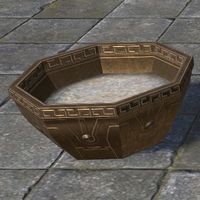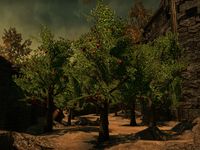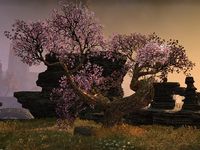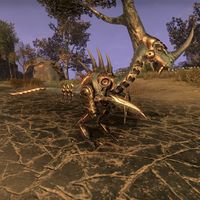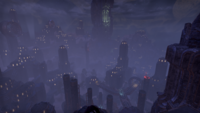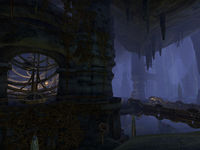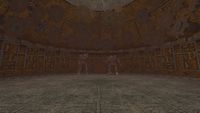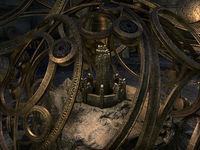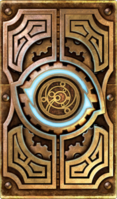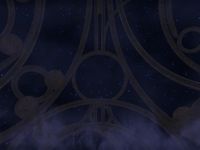Lore:Clockwork City
| Sotha Sil, The Clockwork City | |
|---|---|
| Type | Metaphysical Plane |
| Realm | Mundus |
| Appears in | Tribunal, ESO, Legends |
—The Truth in Sequence
The Clockwork City, also known as Sotha Sil,[1] is a metaphysical clockwork realm that is the greatest creation of Sotha Sil, one of the living gods of Morrowind, to replicate the mythic structures of Nirn in metallic miniature.[2] It supposedly exists "outside space and time",[UOL 1] and in the physical world, it is represented in the form of a Clockwork Globe that is no larger than a good-sized netch, and requires an individual to be magically shrunk to enter.[3][4] Although represented in miniature, the realm is expansive on the inside and encompasses an entire world.[UOL 2]
Location[edit]
The Clockwork City's exact location is shrouded in mystery, with the city itself being described as a "metaphor made manifest". Statements about where the city is located more accurately describe ways to get to the city, rather than the physical location of the city itself.[UOL 2] Sources from various eras had many theories of how to get to the city, many of which led nowhere. As a result, the city attained a mystical status, leading some to doubt its existence. Some theorized that it was accessible somewhere in the southern swamps of Morrowind,[1][UOL 3] in close proximity to Tear,[UOL 4] or beneath the city of Ebonheart.[5] Among all the rumors and speculation on the Clockwork City's entrances, only two were confirmed to have actually existed: One was a rift that opened up in the Abanabi Caves beneath Tel Fyr in 2E 582, which was sealed by Divayth Fyr. The other was the Clockwork Globe, a Tamrielic representation of the city itself.[4] It is said that the city is constantly moving, changing locations throughout different times,[UOL 5] but during the Planemeld, the globe was located in Seht's Vault, within the Dwemer ruins of Bamz-Amschend, deep beneath the Mournhold Temple, in the region Deshaan.[3][6] It is theorized that Sotha Sil chose the location out of his admiration for Dwarven industry.[7]
Skilled mages were able to create devices that allowed them to teleport into the city. The mage Barilzar created the Mazed Band, which enabled its wearer to teleport directly to the city. Telenger the Artificer created the Hyperagonal Locational Determinator, a device that could pinpoint any desired location in the entire Gray Maybe, even those protected by magical defenses including both Artaeum and the Clockwork City.[8] Other skilled mages were occasionally able to teleport to the city when conditions were right.[9] A number of the city's inhabitants arrived in the realm unintentionally and spontaneously.[10][11][12]
History[edit]
First Era[edit]
Genesis and Purpose[edit]
Before the Tribunal's ascension to godhood, Lord Nerevar forged an alliance with the Dwemer. As one of the signs of this friendship, a wing of Kemel-Ze was gifted to Sotha Sil by Dumac Dwarfking.[13] Sotha Sil used this facility to do preliminary work that would later lead to the creation of the Clockwork City, studying the flora and fauna of Nirn to learn how to replicate their functions with metal and energy.[14][15]
After the rise of the Tribunal at the Battle of Red Mountain, to achieve a balance between the material and spiritual world, Sotha Sil focused on mastering both magic and technology.[16] The Clockwork City is a magical and mechanical wonder created by Sotha Sil to serve the noble goal of perfecting what he saw as a flawed Aedric creation.[UOL 2] The goals consisted of ensuring the redemption of Tamriel, unifying competing forces, and destroying the Daedra.[17] From his city, Sotha Sil had hoped to "forge the future"[1] and "reshape the world".[18] His followers, the Clockwork Apostles, interpreted his goal as the creation of a Second Nirn—the Nirn-Ensuing—and a new Tamriel Final. This future world would be free of individual et'Ada,[19] and the Clockwork City would serve as the "center of the wheel".[20] The Apostles deny the existence of Padomay, asserting that there is only the unity of Anu, rendered imperfect in Nirn Extant by its division into "multitudes". The Daedra, they claim, are "of the Nothing", a mere "lie creation tells itself". The Clockwork City would free Anu of these multitudes by forging unity through convergence, synthesizing mer and machine, nature and engineering, and the past and the future. To the Apostles, the greatest threat to this project is the legacy of the Dwemer, whose "ghosts ... cry out, 'Multitudes!'", and above all their "walking horror", the brass god Numidium.[19] In the Second Era, the City's supervising Factotum Aios would name Numidium first among the existential threats to the City.[21]
During the genesis of the city, Sotha Sil developed highly advanced methods to see it through his ambitious vision of a self-contained world made of brass and machinery. He worked on perfecting diminution magic for the purpose of creating his realm in miniature, which enhanced his precision and made the entrance to the city convenient to hide away and store.[3] The glass dome that surrounds the entire realm is known as the Celestiodrome, which functions as the realm's sky and is capable of mimicking the day–night cycle.[22] It contains rotating girders that allow for proper topography to be formed within the realm.[23] Sotha Sil achieved the proper humidity needed for a breathable atmosphere for his realm[23] with the creation of the Halls of Regulation, which maintain the City's water cycle, breathable air, humidity, temperature, wind currents, as well as creating drinkable water.[24] The building known as the Mnemonic Planisphere was created to serve as an extension of Lord Seht's consciousness where his memories were stored in the form of stars. It was maintained for millennia by its caretaker, the Astronomer.[25]
The realm consists of three major areas. The wilderness is known as the Radius, and was created to emulate the various biomes found across Tamriel, overlaid upon a harsh metallic desert. The Brass Fortress is the principal settlement within the Clockwork City, providing shelter from the dangers of the Radius. Underneath it lie the maintenance tunnels of the Mechanical Fundament, which contain the Cogitum Centralis, said to lie in the center of everything and described as the "axle that spins the wheel".[26] It contains Sotha Sil's seat of power, the control center of the city known as the Throne Aligned. Sotha Sil would often vanish into the Cogitum Centralis to work in solitude, sometimes passing decades and even centuries at a time without leaving.[12] It is thought that he reshaped the world from the Throne Aligned.
Despite the Apostles' reprobation of the Dwemer,[19] Sotha Sil drew inspiration from the Dwemer for his creations, and their influence in his work is rumored to be traceable to the time before their disappearance.[27] The Clockwork City's first Factotum, the Precursor, incorporated Dwemer machine parts and significant Dwarven aesthetic influences.[28][29] Among the other Dwemer influences on Sotha Sil's research was the practice of tonal architecture, which he uses to perform his divine workings. He refined it further and created items based on their research, such as tonal forks that could function as a divining rod,[30] and the Resonant Sphere, one of Sotha Sil's minor marvels. The sphere produces an aural response upon the application of magic, and chimes with a sound similar to those that ring in the Brass Fortress.[31] The enormous processing facility known as the Halls of Fabrication, which refactors the materials and iterates the designs for the City's machines, at one point broke down Dwemer machinery so that their materials could be repurposed into Sotha Sil's own creations. He later halted this practice, however, leaving the Assembly General to continue improving the designs without Dwemer parts according to his own "Glorious Design".[32] It is said that the City may actually just be one big living machine.[UOL 5] Ultimately his style became his own and the city's structures, vegetation, and wildlife are all mechanical constructs of his own design.[33]
Sotha Sil was also interested in dark magic[UOL 5] and experimenting with his own divine energy. As such, he built the Divinity Atelier - a workshop and reservoir where he used the artifact Sunna'rah to drain away minute pieces of his essence to store and study.[3]
Luciana Pullo[edit]
In 1E 2712, a battlemage of Reman Cyrodiil's army, Luciana Pullo, was transported to the city after an explosion of magical energy. Sotha Sil found her gravely wounded on the outskirts of The Radius and used his advanced technology to save her life and deliver her premature son. Luciana decided to join the ranks of the Clockwork Apostles, rising through their ranks to become a proctor as she raised her son Marius. Sotha Sil prophesied to her that he had saved them because she would one day shine a light. Luciana later discovered that her son had a terminal heart defect, a result of circumstances of his birth. Sotha Sil entered the Cogitum Centralis in 1E 2721, and when Marius' condition worsened, Proctor Luciana forcefully entered the Centralis in 1E 2730 to ask the living god to save his life. Sotha Sil refused, stating that while he had the power to heal Marius, circumstances made it impossible. He then teleported Luciana back to the city and continued his seclusion in the Centralis until at least 1E 2750. Luciana would remain a proctor within the clockwork apostles but would lose her love for Sotha Sil.[12]
Second Era[edit]
The Daedric Triad[edit]
As part of The Triad's goals in 2E 582, Clavicus Vile and Barbas carried out an elaborate plot to gain access to the Clockwork City. They used a powerful staff created by Sotha Sil, Sunna'rah, to steal Vivec's divine energy and use it to discover the city's location. They succeeded, and Barbas entered the City to arrange Clavicus Vile's arrival, but was stopped by the Vestige and the mage Barilzar, who pursued him into the City.[4]
Around the same time, a portal to the Clockwork City inexplicably opened up inside the Abanabi Caves when Divayth Fyr undertook to extend his tower there, spilling out Refabricants and Fabricants from the Halls of Fabrication. The Fabricant threat was neutralized when a large group of Undaunted accompanied Divayth Fyr into the cave and entered the Clockwork City portal, defeated the Assembly General, and disabled the Fabricants' production. Divayth then studied the portal.[34]
Nocturnal subsequently tried to take control of the Clockwork City. She summoned Sotha Sil's Shadow, who replaced him as ruler of the Clockwork City. Nocturnal's Skeleton Key was accidentally found by a Factotum beneath the Brass Fortress. The Clockwork Apostle Chancellor Gascone Dusant sought to deliver it to Clavicus Vile, only for the Key to be stolen by the Blackfeather Court. The Vestige, assisted by Divayth Fyr and the Clockwork Apostles, unveiled the plot, but was unable to reclaim the Skeleton Key before it was taken by Sotha Sil's Shadow.
Nocturnal and the Shadow then attempted to seize control of the Clockwork City by using the key to try unseat the real Sotha Sil from his Throne Aligned and replace him with his Shadow. The Vestige and Luciana intervened and defeated the Shadow in combat, but Nocturnal had her shadows envelop the area as a countermeasure in an attempt to consume the heroes. Proctor Luciana Pullo would not yield, and at the last second used her shadow-banishing light to keep Nocturnal's forces at bay. Divayth Fyr also arrived at the last second and used his magic to keep Sotha Sil alive and constrain the shadow. These actions bought the Vestige enough time to remove the Skeleton Key from the Throne Aligned and awaken Sotha Sil. Sotha Sil would then reunite with his shadow and banish Nocturnal from his realm.
Luciana collapsed from exhaustion as a result of the fight but fulfilled Sotha Sil's prophecy that she would someday shine a light. Sotha Sil offered the Vestige a Boon for their aid, but it is unknown if they chose to acquire immediate power or to save Luciana's life and delay her death to a later time. Sotha Sil gave the Skeleton Key to Divayth Fyr for safekeeping and returned to the Cogitum Centralis to make preparations against the Daedric Triad. [6]
The Insane Temple Saints[edit]
In an attempt to unlock the secrets to everlasting life, Sotha Sil created mechanical vessels for the souls of three revered Tribunal Temple Saints: Saint Felms, Saint Llothis, and Saint Olms.[35] The mechanical transformation turned the saints mad and they were sealed away in the Asylum Sanctorium. The Asylum would become a place where people would come make offerings to the saints but over time the minds of the saints eroded even further.[36]
Around the same time as Nocturnal's attempt to take control of the Clockwork City, the Undaunted were tasked with putting an end to their suffering before they could threaten the Clockwork City.[36]
The Mechanical Heart[edit]
In 2E 882, Dagoth Ur awakened and then ambushed and nearly killed the Tribunal during their annual pilgrimage to Red Mountain to renew their divine powers. The event resulted in the Tribunal being cut off from access to the Heart of Lorkhan, and caused Sotha Sil to respond by beginning development of a replacement heart. His solution was the Mechanical Heart, a mechanical replication of the Heart of Lorkhan, which would act as a new source of divinity and power for his Clockwork City.[37] Its development would not go smoothly, however, as the Heart became unstable in its early development. To prevent the Heart from destroying the City, he created his own variant of Kagrenac's Tools to control, shape, or even dismantle the Heart if necessary.[38] Sotha Sil went to great lengths to keep the Heart from those who would misuse it. It was stored and would continue to be developed under heavy security in the Chamber of Lorkhan, located deep in the Clockwork City's Cogitum Centralis. The Cogitum Centralis contained an automated defense system controlled by a master Factotum.[21] Sotha Sil also hid his tools across Nirn as a precaution to prevent others from stealing the Heart's power.[39]
Third Era[edit]
After the loss of Kagrenac's Tools to Dagoth Ur's minions at Red Mountain in 3E 417, Sotha Sil retired to the city and slowly became almost completely detached from the real world.[40] Scholars still attempted to gain permission to study in the city during this time.[41]
Sotha Sil continued developing the Mechanical Heart, but its progress would be threatened as the day arrived, just as he predicted, on which his friend Almalexia would come to kill him.[21][42] In 3E 427, the goddess Almalexia, having been driven mad by her loss of immortality, manipulated the Nerevarine to retrieve Barilzar's Mazed Band, which she used to travel to the Clockwork City to murder Sotha Sil in cold blood. When Almalexia came face to face with Sotha Sil, he said not one word, making her think that even in death, Sotha Sil mocked her with silence.[43] In reality, he was likely in another state of mind and was unable to respond, a result of being plugged into the control center within the Dome of Sotha Sil.[42]
In his final moments, Sotha Sil attempted to use his control center to seal the Chamber of Lorkhan to prevent the Heart from falling into the wrong hands and to ensure the City would live on after his death. He was successful in sealing the Chamber and his machines began finishing the construction of the Mechanical Heart within it. After murdering Sotha Sil, Almalexia transported his fabricants into Mournhold to wreak havoc. She then tricked the Nerevarine into going to the Clockwork City to kill the late Sotha Sil, whom she blamed for the attacks. Once there, she attempted to murder the Nerevarine as well, but the waning of her divinity had diminished her powers, and the Nerevarine struck her down.[40]
Fourth Era[edit]
The Heart continued to be constructed by Sotha Sil's Machines within the Chamber of Lorkhan, and 207 years after Sotha Sil's death, in 4E 200, it was completed. Sotha Sil's creations had previously required his presence, with the City's functions going into a slumbering mode in his absence.[44] With the Heart now powering the City and sustaining its inhabitants even after his demise, his presence was no longer needed.[42]
The Fate of the City[edit]
In 4E 201, Mecinar, a former Clockwork Apostle who was banished from the city for his perverse research into the creation of the perfect lifeform,[45] employed treasure hunters from across Tamriel to retrieve Barilzar's Mazed Band in order to return to the City and see his vision through. Hoping to claim the riches within the city for themselves,[46] the Forgotten Hero and their adventuring party tracked the Band to Forelhost in the Rift. Unbeknownst to the heroes, the treasure hunters in the employ of Mecinar were following them, and easily stole the Band from them after they were weakened. The Forgotten Hero's friend, an Argonian named Swims-at-Night, would not give up his prize, however, and was teleported into the city along with them after he took hold of the hunters while they were using the ring.[47] The Forgotten Hero would not forsake their friend, and would pursue another way into the city. They would eventually find their solution in Alfe Fyr, one of the daughters of Divayth Fyr, who lived near Mount Anthor. After sending them upon an errand that was actually meant to kill them, Alfe Fyr teleported them into the Clockwork City.[48]
Once inside, the heroes ventured to the Brass Fortress and discovered the last of Clockwork City's people, who initially attacked them out of fear that they were associated with the hunters who had recently raided them. The heroes discovered that the City's inhabitants at that time were led by the Clockwork Apostle known as Galyn the Shelterer, who was compassionate about his people and intended to keep them alive at any cost. He sent the heroes to follow the treasure hunters, and they were able to rescue their friend and recover a memory star of Sotha Sil. What was meant as a rescue mission would now turn into a race against time, as the star revealed the existence of the Mechanical Heart. The heroes decided to traverse the dangers of the Cogitum Centralis, located in the depths of the city, to prevent the Heart from falling into the wrong hands.[49]
Their good intentions would have disastrous results. Mecinar had spent centuries devising his plot, and had modified his body into a tool that could absorb the Heart's power. He waited from the shadows until the heroes unsealed the Chamber of Lorkhan. With the Heart unveiled, he seized the opportunity to realize his plans and basked in the artifact's power.[50] The heroes barely survived the encounter. Among the rubble, they came across another memory star that revealed that Sotha Sil had created his own replica of Kagrenac's Tools, which could control, shape, and even dismantle the Heart. Acting on this revelation, the heroes journeyed to find the tools,[51] and discovered that Mecinar was now carrying out his plan to remake the City in his own image, turning its people into abominations. After being put to flight by a Fabricant attack, a brave sacrifice was made and the hero lost one of their friends.
The heroes ventured onward to the Throne Aligned, where it was revealed that Sotha Sil's tools had been hidden across Tamriel. The Forgotten Hero was able to collect the tools using the Doors of Egress, the Clockwork Apostles' teleportation device, and entered the Chamber of Lorkhan to challenge Mecinar. Mecinar was defeated, but the consequences of the confrontation are unclear. One rumor states that the Forgotten Hero destroyed the Heart, and the Clockwork City's inhabitants were forced to abandon it as it ceased to function.[52] Another account holds that the hero used the Heart to harness its power and fought Mecinar on equal ground, allowing the Heart to live on along with the city. The Heart's power overwhelmed the Hero and they disintegrated, it is claimed, but their consciousness lived on within the City.[53][54]
Society[edit]
Four major groups of people exist in the Clockwork City and have developed their own communities.
The Clockwork Apostles reside in the Clockwork Basilica within the Brass Fortress and revere Sotha Sil. Becoming an Apostle requires great skill—whether in magic, machinery, or some other field deemed worthy at the City. Clockwork Apostles often replace their limbs with clockwork prosthetics, correcting what they see as a flawed part created by the et'Ada with a perfect part created in Sotha Sil's design, usually as an expression of faith.[UOL 2][55] Despite Sotha Sil's earlier influences from the Dwemer, the Clockwork Apostles see Dwemer creations as inferior and even blasphemous.[19] They are often seen as elitist by non-Apostles, and frequently send others to perform tasks that they deem beneath them.[56] They follow sermons of The Truth in Sequence as a sacred text,[20] and devote their work towards one goal: the creation of Tamriel Final, a new Nirn.[19] The highest-ranking Apostles form the governing body of the City, the Congress of Calibration.[57]
Those that lack the proficiency required to become a Clockwork Apostle but have some other desirable skill are referred to as auxiliaries. These can be skilled adventurers for hire or practitioners of other trades, such as merchants, craftsmen, and other roles.[58] They usually dwell within the Brass Fortress in sections outside the Clockwork Basilica and Slag Town. Merchants gather to sell their goods in the Chancel of Transaction near the center of the Brass Fortress while craftsmen reside in the Hall of Refined Techniques. Carpenters go to sell their furniture in the Domicile Enhancement Hub near Slag Town.
Those who lack any desirable skills are cast out and become Tarnished.[33] The Tarnished live in the slums of Slag Town and in the Outlaws' Refuge. They feel abandoned by the Clockwork Apostles,[59] and often have to rely on themselves to get by. In the Second Era, the Orc Razgurug ran Slag Town as its unofficial mayor and would help keep stock of Slag Town's supplies. The mayor frequently petitioned for the Clockwork Apostles' help but was rarely met with a positive response. As a result, he enlisted adventurers to help obtain necessities to treat the sick among the Tarnished, fuel their fires for warmth, and improve their overall quality of life.[60]
Citizens of the city referred to outsiders as exodromals (those from the "Nirn Above" beyond the celestiodrome).[22] To gain citizenship in the Brass Fortress, one had to find a sponsor among the city's inhabitants who would be willing to vouch for them. In most cases, new citizens had no way to return to Tamriel, and consequently had no choice but to stay in the Clockwork City forever.[6] The Apostles have access to the device known as the Doors of Egress, which allows them to teleport anywhere in Tamriel,[39] but citizens of the City are told that it does not exist.[61] Some felt that life in the realm was a miracle,[62] while others considered it an unending nightmare.[63]
Food[edit]
The denizens of the Clockwork City are unlikely to go hungry thanks to the staple food known as Nutriment Paste. It is served from devices known as nutriment dispensers, and the food itself is thick, flavorless, healthy, and above all, a filling paste that has the consistency of porridge. Spices or toppings are added to make it a bit more palatable. The lack of pleasure the paste provides is said to make the simple flavors of other foods become the most delicious things ever tasted.[64][65] The paste sometimes causes people to contract an affliction known as Cyclical Inert Ingestion, a palate fatigue which gives them compulsive cravings, causing them to experiment with ingesting non-nutritious and sometimes harmful materials.[66] The Paste can be repurposed into nutrient pellets that are used to feed fabricant livestock.[67]
Merchants in the City see real ingredients as a privilege, not a right. Some are disdanful towards the Tarnished for their desperation,[68] and may even refuse to sell outside food to the few Tarnished that can afford it. As a result, the people of Slag Town have few alternatives to Nutriment Paste. The Vestige was able to expand the food palate of Slag Town's denizens when they retrieved the notes detailing the process to make the transient fungi known as Ironstalk Mushrooms edible.[69][70][71] The mushroom's introduction also allowed them to enjoy fabricant meat, as the mushrooms took off the edge that came from eating it.[72]
The Everwound Wellspring offers an alternative to the flavorless Nutriment Paste. Various fruits and vegetables are grown there despite the poor environmental conditions with the aid of a reservoir of water, artificial lighting, and alchemical nutrients.[73] The cost of maintaining the Wellspring is high, as a person's lifeforce is required to sustain it, making it impractical to rely on the Wellspring as an alternative to Nutriment Paste.[74]
Ecosystem[edit]
Sotha Sil's realm is completely synthetic and inhospitable to most forms of organic life. Various life of metallic and organic origin were created for the purpose of thriving in this synthetic environment.
Flora[edit]
The Clockwork City consists of both synthetic and natural vegetation. As the metallic soil precluded the growth of natural vegetation, artificial vegetation that mimicked Nirn's species was created and placed into the landscape. Natural vegetation was once a rare sight, being limited to a small number of areas such as the Everwound Wellspring.[73] By the Fourth Era, the Mechanical Heart allowed genuine flora to thrive in the Clockwork City, overrunning it with vibrant flora. At that time, vines covered the clockwork architecture and various forms of plant life even penetrated out from the City's buildings.[52]
Fauna[edit]
Various mechanomagical lifeforms inhabit the Clockwork City. Among them are the Fabricants, creatures that are part organic, part inorganic, which are designed to emulate the form and behavior of their Tamrielic counterparts. They are constructed from an amalgam of grown flesh and metallic graft, and are powered by soul gems.[73] They come in a wide variety of shapes, but are usually created to emulate carnivorous animals since the synthetic realm is inhospitable to most forms of organic plant life. They can resemble any creatures of the land, air, and sea from Nirn Above. Unique to the Clockwork City are the Verminous Fabricant and the Hulking Fabricant, two creatures with no obvious counterpart on Nirn.[75][76] They are also known as the Fabri'siraynosim, the merged-ones,[19] and are rumored to be the first step towards the convergence of Nature and engineering.[33]
The other major group of fauna in the Clockwork City are Factotums, constructs that are completely synthetic and usually humanoid in appearance. They fulfill a wide variety of functions, such as performing maintenance, providing security, and even acting as bards.[77][78][79] Early model Factotums are referred to as Refabricants, and were part of Sotha Sil's efforts of taking Dwemeri design and making it his own. They contain Dwemeri parts that have been repurposed as well as having a more Dwemeri-inspired design.[80][81] Factotums have been improved over time, with modern Factotums being the series 7 model and no longer having any Dwemer parts or Dwemer inspired physical features. Factotums have also been experimented with and mortal souls have been successfully transferred into them, but a common defect is that it may make the subject turn insane, with the most notable examples being the three Dunmeri Saints.
Refabricated Dwemer constructs also dwell in the Clockwork City but are a rarity. They are unique from regular Dwemer constructs in that they have been tinkered in ways beyond the capabilities of even the most talented individuals.[7][82]
A fourth type of fauna are known as Abominations,[83] and were created by the former Clockwork Apostle Mecinar, one of Sotha Sil's brightest apostles. Influenced by Sotha Sil's work, he strove for the creation of the perfect life form.[45] He modified Acolytes against their will and combined them with steel and sorcery similar to Fabricants, but went a step further and merged them with beasts. In the eyes of Sotha Sil they were abominations and as a result he exiled Mecinar from the city.[45] In the Fourth Era, after returning to the Clockwork City and obtaining the divine power from the Mechanical Heart, Mecinar attempted to remake the citizens of the City in his own image,[84] and was able to even turn the undead into mechanical slave abominations using the divine powers he obtained from the Heart.[85][86]
Notable Places[edit]
- The Radius
- The outskirts of the Clockwork City.
- Brass Fortress
- The City within the Clockwork City.
- Cogitum Centralis
- The Cogitum Centralis, which contain the Throne Aligned, the control center of the Clockwork City.
- Central Gearworks
- Dome of Kasia
- Dome of the Imperfect
- Dome of Serlyn
- Dome of Udok
- Hall of Mileitho
- Hall of Sallaemu
- Halls of Regulation
- Treatment facility for the Clockwork City's breathable air and drinkable water, and precisely controls humidity, temperature, and wind currents.
Gallery[edit]
-
The Clockwork City themed card back as seen in Legends
See Also[edit]
- For game-specific information, see the Tribunal, Elder Scrolls Online
 , and Legends articles.
, and Legends articles.
Books[edit]
- Barilzar's Journal by Barilzar, Apprentice to Sotha Sil — An apprentice mage records his time in the Clockwork City
- Catalogue of Afflictions in the City — An outline of the most common afflictions in the Clockwork City
- Excerpts From Fabricated Flora: A Study by Acolyte Kelvivi — Research notes on a fully organic organism found in the Clockwork City
- Factotum Classification - Log 233 by Proctor Neimos, Apostle of Sotha Sil — A description of each factotum subgroup found in the Clockwork City
- The Fabricated Fauna of Clockwork by Endilaril, Naturalist — A naturalist's research notes on the Clockwork City's artificial wildlife
- Naril's Notes: Origins by Lector Naril — Research notes on the origins of the Everwound Wellspring
- On the Clockwork City by Barilzar, Mage of the Seventh Order and Artificer Extraordinaire — A mage's memories of Sotha Sil's city
- Realms of the Clockwork City: The Radius by Provost Varil Arvel — Excerpt from a series describing the regions of the Clockwork City
- The Truth in Sequence by Deldrise Morvayn, Fourth Tourbillon to the Mainspring Ever-Wound — Sermons on the metaphysics of Sotha Sil
- The Unseen Potential of Clockwork by Lector Saelorn Tenar, Apostle of Sotha Sil — An essay exploring the true potential of the Clockwork City
- The Water Cycle of Clockwork City by Varlinsi Arandu, Apostle of Sotha Sil — An explanation of Clockwork City's water purification process
References[edit]
- ^ a b c Pocket Guide to the Empire, 1st Edition: Morrowind — Imperial Geographical Society, 2E 864
- ^ Clockwork City loading screen in ESO
- ^ a b c d Barilzar's dialogue in ESO: Morrowind
- ^ a b c Events of ESO: Morrowind
- ^ 2920, Evening Star — Carlovac Townway
- ^ a b c Events of ESO: Clockwork City
- ^ a b Divayth Fyr's dialogue in ESO
- ^ Razum-dar's Journal, Chapter 1 — Razum-dar
- ^ Outsider Observation Report - Log 1 — Rosalind Frenrick, Stranded Mage
- ^ Dulza's Log — Dulza gra-Morkul, Merchant of Fell's Run
- ^ Journal of a Stranded Mage — Orinol, Mage of Cormount
- ^ a b c Proctor Luciana's Journal — Proctor Luciana Pullo
- ^ Thoryn Armas' dialogue in ESO
- ^ Sotha Sil's dialogue in ESO: Necrom
- ^ Protus' dialogue in ESO
- ^ The Elder Scrolls V: Skyrim Tarot Deck and Guidebook Temperance Card, pg 41
- ^ Sotha Sil's dialogue in ESO: Clockwork City
- ^ Varieties of Faith... — Brother Mikhael Karkuxor of the Imperial College
- ^ a b c d e f The Truth in Sequence — Deldrise Morvayn, Fourth Tourbillon to the Mainspring Ever-Wound
- ^ a b The Unseen Potential of Clockwork — Lector Saelorn Tenar, Apostle of Sotha Sil
- ^ a b c Aios' dialogue in ESO: Clockwork City
- ^ a b Provost Varuni Arvel's dialogue
- ^ a b Dialogue of various Stars in the Mnemonic Planisphere
- ^ The Clockwork City Adventure Guide on the official ESO website
- ^ The Astronomer's dialogue in ESO: Clockwork City
- ^ Proctor Luciana Pullo's dialogue in ESO: Clockwork City
- ^ 36 Lessons of Vivec, Sermon 36 — Vivec
- ^ Associate Zanon's dialogue in ESO: Clockwork City
- ^ The Precursor's dialogue in ESO: Clockwork City
- ^ Divaricated Tone Fork item in ESO
- ^ Raynor Vanos' dialogue in ESO: Clockwork City
- ^ Cogitation Log 1322331455212478
- ^ a b c What is the Clockwork City? on the official ESO website
- ^ Forging the Future quest in ESO: Morrowind
- ^ Asylum Sanctorium loading screen text in ESO
- ^ a b Introducing the Asylum Sanctorium on the official ESO website
- ^ Events that occur in the mission The Red Mountain in Return to Clockwork City
- ^ The Tools in Return to Clockwork City
- ^ a b The Throne Aligned in Return to Clockwork City
- ^ a b Events of Morrowind: Tribunal
- ^ Hrundi's dialogue on Sondaale of Shimmerene in Morrowind
- ^ a b c The Last Stand in Return to Clockwork City
- ^ Almalexia's dialogue in Morrowind: Tribunal
- ^ Luciana Pullo' dialogue in the ESO: Clockwork City
- ^ a b c The Betrayal in Return to Clockwork City
- ^ Offer From a Friend in Return to Clockwork City
- ^ Treasure Denied in Return to Clockwork City
- ^ Return to Alfe Fyr in Return to Clockwork City
- ^ Episode 4 Intro in Return to Clockwork City
- ^ The Inner Curiosity in Return to Clockwork City
- ^ The Tools in Return to Clockwork City
- ^ a b The City Falls in Return to Clockwork City
- ^ Journey's End in Return to Clockwork City
- ^ Events of Return to Clockwork City
- ^ Crafting Motif 56: Apostle — Artificer Dalomar
- ^ Inveigling the Clockwork Apostles — A Helpful Citizen
- ^ Neramo's dialogue in ESO: Clockwork City
- ^ Outsider Observation Report - Log 2 — Rosalind Frenrick, Stranded Mage
- ^ Stuck in the Slag — Circone, Good Deputy of Slag Town
- ^ Razgurug's dialogue in ESO: Clockwork City
- ^ Sarvlos Velar's dialogue in ESO: Clockwork City
- ^ Barilzar's Journal — Barilzar, Apprentice to Sotha Sil
- ^ Outsider Observation Report - Log 3 — Rosalind Frenrick, Stranded Mage
- ^ Outsider Observation Report - Log 2 — Rosalind Frenrick, Stranded Mage
- ^ Flavorless Paste on the official UESP ESO item database
- ^ Catalogue of Afflictions in the City
- ^ Nutrient Pellets in ESO
- ^ Ingunnen's dialogue in ESO: Clockwork City
- ^ Ironstalk Mushroom Preservation and Sterilization — Salas Ramothran
- ^ Excerpts From Fabricated Flora: A Study — Acolyte Kelvivi
- ^ Chirrhari's Notes — Apprentice Chirrhari
- ^ Brengolin's dialogue in the ESO: Clockwork City
- ^ a b c Realms of the Clockwork City: The Radius — Provost Varil Arvel
- ^ Lector Naril's dialogue in ESO: Clockwork City
- ^ A Study of Fabricants — Endilaril, Naturalist
- ^ The Fabricated Fauna of Clockwork — Endilaril, Naturalist
- ^ The Mystery of Factotums — Associate Zanon, Clockwork Apostle
- ^ The Factotum's Secret Voice — Lector Tidras Dran, Clockwork Apostle
- ^ Factotum Classification - Log 233 — Proctor Neimos, Apostle of Sotha Sil
- ^ Refabricant Slayer achievement description in ESO
- ^ Crafting Motif 79: Refabricated Style — Dreyla Indavel, Halls of Fabrication
- ^ Appearance of Refabricated Arquebus, Ruptured Centurion, and Ordinated Protector in ESO
- ^ Abomination's card appearance in Return to Clockwork City
- ^ The Caminus Pit in Return to Clockwork City
- ^ Swims-at-Night's Abomination appearance in Return to The Inner Curiosity in Return to Clockwork City
- ^ Laaneth's Abomination appearance in Return to The Inner Curiosity in Return to Clockwork City
Note: The following references are considered to be unofficial sources. They are included to round off this article and may not be authoritative or conclusive.
